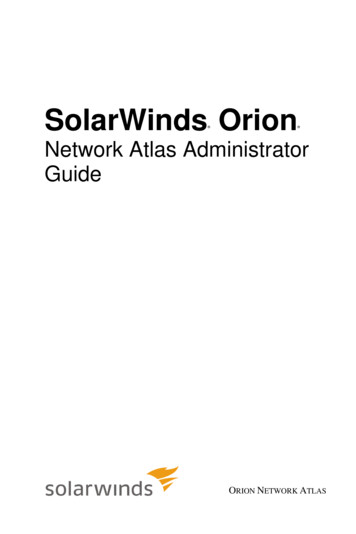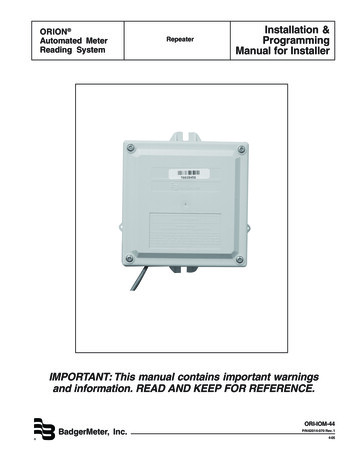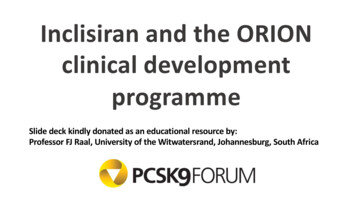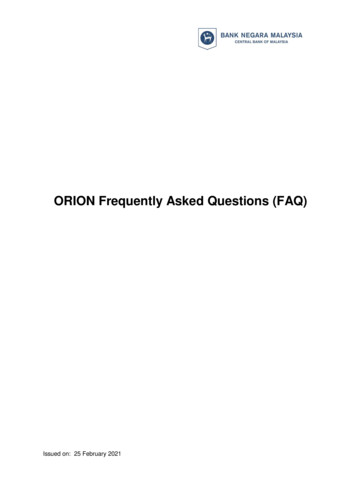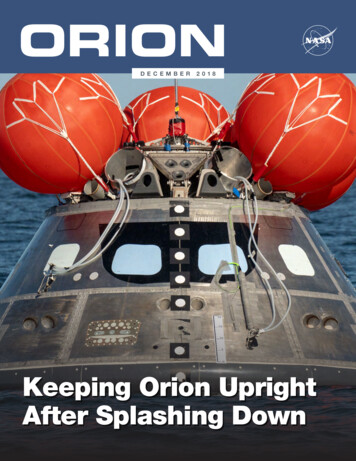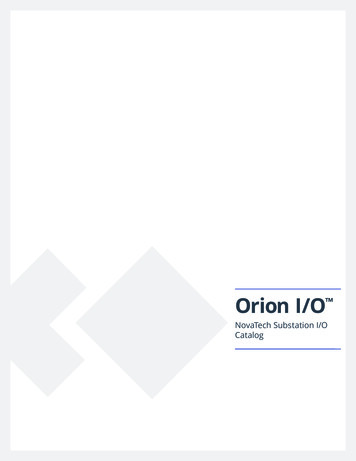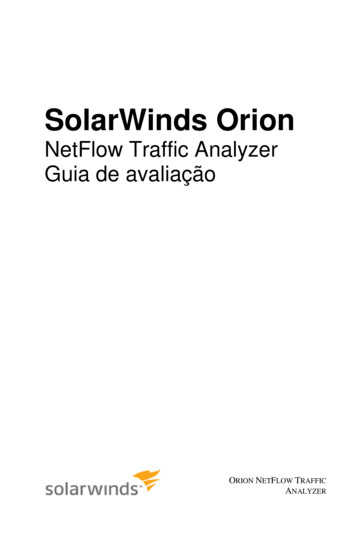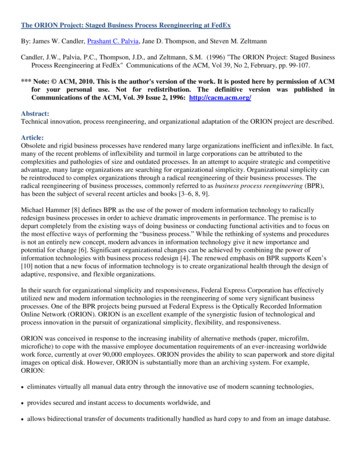
Transcription
The ORION Project: Staged Business Process Reengineering at FedExBy: James W. Candler, Prashant C. Palvia, Jane D. Thompson, and Steven M. ZeltmannCandler, J.W., Palvia, P.C., Thompson, J.D., and Zeltmann, S.M. (1996) "The ORION Project: Staged BusinessProcess Reengineering at FedEx" Communications of the ACM, Vol 39, No 2, February, pp. 99-107.*** Note: ACM, 2010. This is the author's version of the work. It is posted here by permission of ACMfor your personal use. Not for redistribution. The definitive version was published inCommunications of the ACM, Vol. 39 Issue 2, 1996: http://cacm.acm.org/Abstract:Technical innovation, process reengineering, and organizational adaptation of the ORION project are described.Article:Obsolete and rigid business processes have rendered many large organizations inefficient and inflexible. In fact,many of the recent problems of inflexibility and turmoil in large corporations can be attributed to thecomplexities and pathologies of size and outdated processes. In an attempt to acquire strategic and competitiveadvantage, many large organizations are searching for organizational simplicity. Organizational simplicity canbe reintroduced to complex organizations through a radical reengineering of their business processes. Theradical reengineering of business processes, commonly referred to as business process reengineering (BPR),has been the subject of several recent articles and books [3–6, 8, 9].Michael Hammer [8] defines BPR as the use of the power of modern information technology to radicallyredesign business processes in order to achieve dramatic improvements in performance. The premise is todepart completely from the existing ways of doing business or conducting functional activities and to focus onthe most effective ways of performing the ―business process.‖ While the rethinking of systems and proceduresis not an entirely new concept, modern advances in information technology give it new importance andpotential for change [6]. Significant organizational changes can be achieved by combining the power ofinformation technologies with business process redesign [4]. The renewed emphasis on BPR supports Keen’s[10] notion that a new focus of information technology is to create organizational health through the design ofadaptive, responsive, and flexible organizations.In their search for organizational simplicity and responsiveness, Federal Express Corporation has effectivelyutilized new and modern information technologies in the reengineering of some very significant businessprocesses. One of the BPR projects being pursued at Federal Express is the Optically Recorded InformationOnline Network (ORION). ORION is an excellent example of the synergistic fusion of technological andprocess innovation in the pursuit of organizational simplicity, flexibility, and responsiveness.ORION was conceived in response to the increasing inability of alternative methods (paper, microfilm,microfiche) to cope with the massive employee documentation requirements of an ever-increasing worldwidework force, currently at over 90,000 employees. ORION provides the ability to scan paperwork and store digitalimages on optical disk. However, ORION is substantially more than an archiving system. For example,ORION: eliminates virtually all manual data entry through the innovative use of modern scanning technologies, provides secured and instant access to documents worldwide, and allows bidirectional transfer of documents traditionally handled as hard copy to and from an image database.
Figure 1. ORION’s Integrated systems conceptThe ORION project, while significant in concept and scope, is a realistic implementation of the emergingwisdom on the application of BPR. The intense interest in BPR has led to myths and unrealistic expectations.Davenport and Stoddard [5] explore several such myths and note that high expectations and ensuing frustrationshave contributed to the failure of many promising reengineering efforts. They go on to say that BPR is notsynonymous with total organization transformation; at best it involves the transformation of a few workprocesses. ORION’s scope is consistent with this pragmatic observation and includes the document-handlingprocesses within the human resources division of Federal Express.The ORION description in this article embodies two elements: the technical innovation itself and its adoption inan organizational environment ([18, 19]). ORION’s technical innovations are discussed in the next two sectionsto provide a basic understanding of the technical aspects. It is important to note, however, that the project didnot dwell on technology per se; ORION was conceived and implemented in order to effect a comprehensivereengineering of organizational processes. The project team understood the possibilities offered by newlyemerging technologies and utilized them effectively for process redesign. The third and fourth sections describethe process reengineering aspects; subsequent sections describe specific organizational benefits and key factorsfor ORION’s success.Technical OverviewArchival storage of paper documents is massive and their processing inherently slow. The concept of the―paperless office,‖ therefore, is an attractive option to organizations. Yet its implementation to date remainslargely elusive. Complete process automation by the elimination of paper documents now appears to be highlyimprobable. The fact that many organizations have invested in imaging systems may constitute as furtherevidence that the concept is currently untenable.However, major steps can be taken toward this goal. ORION is a good example of a properly conceived andimplemented project that can be a major contributor to the quest for the ―paperless office.‖ ORION recognizesthat document imaging and electronic signatures will not totally negate the need for paper documents. However,once created, these documents can be converted to their electronic forms and all subsequent processing can be―paperless‖ and increasingly automated.
The weaknesses of paper-intensive processes include the time delays and errors associated with the physicalmovement of paper, not just the existence of the paper itself. Whether across the room or across the globe, theelectronic, instantaneous movement of documents eliminates many of the negatives of paper processes whilepreserving the benefits provided by paper documents.Many document-imaging projects under way today fail to recognize the full power of imaging technologybecause of a limited perspective. The ORION project team, while well versed in technology, did not allow thisfamiliarity to obscure the mission of reengineering the process. The team fully examined the goals of existingorganizational processes from the perspective of optimizing them. This approach allowed the team to exploittechnologies to a level previously not conceived. In their effort to provide maximum ease of use andfunctionality to their constituents, the project team developed an integrated systems approach in designingORION. The result is a user-friendly and functional system that either eliminates or vastly simplifies manyunwieldy manual processes.Integrated Imaging SystemsThere are three primary approaches to the creation of imaging systems (see Figure 1). Most computer-basedimaging systems are standalone systems, which replace manual archive systems. Standalone systems canprovide compact storage of huge numbers of documents, typically by utilizing optical disks. These systems canalso serve as an efficient means of locating documents through the use of computer-based indexing schemes anddirect-access storage devices. In fact, these two benefits are the primary attractions of the vast majority ofcomputer-based image storage and retrieval systems in use today (see Figure 1a).More advanced computer-based imaging systems have interfaces with other corporate systems, which providefor the inter-system transfer of data. Each of these systems functions independently, but they have the capabilityto work together in specific ways. For example, an imaging system capturing accounts payable documentsmight have access to accounts payable data files (such as an authorized vendor list or other vendor masterfiledata). These advanced systems can automate some clerical duties and provide various checks before an image iscommitted to disk (see Figure 1b).The most advanced computer-based imaging system is designed as an integrated system to work with one ormore other computer-based systems (see Figure 1c). Such is the case with ORION. ORION is integrated withthe Federal Express corporate human resource (HR) system. This HR system was described in detail in [13].The advantages of an integrated system are numerous:The operation of the imaging system is ―seamless‖ with other systems within the integration. The imagingcomponent appears as just another system feature to the user. ORION’s technology is ―behind the scenes‖ andtransparent to the user. Data is stored in system databases and accessed directly, and need not be transferred between systems. Thereare no delays and no multiple protocols to be invoked. Another advantage of single system-wide databases is enhanced data integrity. Data integrity includesminimization of data redundancy, improvement of data maintenance, and elimination of multiple versions ofdata.FunctionalityThe ORION system is completely integrated with the corporate human resources system. In effect, ORION has―image-enabled‖ the HR system. ORION’s function is to record, store, and disseminate electronic images of HRdocuments to and from authorized parties as determined by the HR system. Integration between ORION andcorporate HR applications is so effective that there was no need to modify existing security and audit features tocontrol and monitor ORION activity.
ORION appears as a ―document-handling‖ application of the HR system. The user makes all document requeststo the HR system. Completely transparent to the user, these requests are translated internally by the system (i.e.,by the intersection slice in Figure 1c) into ORION requests. These requests are then executed by ORION withappropriate storage or dissemination actions.Process reengineering has allowed ORION’s functionality to go significantly beyond simple document storageand retrieval. For example, ORION can transmit images to and receive them from any facsimile machinethrough use of the common carrier network. Images can also be transmitted to and received from image-capableworkstations on the company’s global telecommunications network and can be printed on image-capablenetwork printers. ORION is also designed to work with local-area net-works (LANs) that have access to theglobal network.The Stages of Reengineering in ORIONThe reengineering effort in ORION is pragmatic and realistic. Prevailing myths and anecdotal remarks ([8, 9])suggest that process reengineering calls for total organizational transformation and obliteration of existingprocesses. Davenport and Stoddard [5] observe that while these myths have rhetorical power, they arefundamentally false. In accordance with this pragmatic perspective, ORION was planned to have a three- stagedevelopment path, the stages corresponding to anticipated technology acquisitions by Federal Express. Eachstage introduces higher levels of reengineering into the process. Currently, most organizational subunits are atthe end of the second stage, and pilot implementation of the third stage has begun.f ORIONFigure 2. Factors contributing to the staging of ORIONSeveral factors contributed to the staging of ORION (Figure 2). First, a computer network capable oftransmitting high-volume image-based traffic is required to fully utilize ORION’s capabilities. The size of atypical image page (averaging 40KB) is too large for the current character-based network to handle. The secondfactor was the lack of wide availability of networked computer terminals with a graphical user interface (GUI).GUI terminals, configured to process high-resolution electronic document images, are now being positionedwithin the company to support projects of corporate-wide and global impact. ORION is one such project.Finally, staging has allowed designers and implementers to effectively plan for the massive change caused bythe reengineered processes. This strategy has allowed the organization to keep the scope of change manageableat every stage, both organizationally and technologically.
Figure 3. ORION “auto indexing” and mark senseThe completion of the third stage will maximize process change and yield optimal global effectiveness. At thisstage, LANs will be able to support high-speed, high-volume, synergistic wide-area links. With expandingnetworking capabilities, ORION will be positioned to take full advantage of the move to a client/serverarchitecture with its LANs, GUI terminals, and access to the high-speed global network. The process changesintroduced in each stage are summarized in the following subsections.The Three Stages of InputStage 1 is global in scope, but due to network delivery constraints, volume is low. The 35,000 character-basedterminals process requests for documents with-in the ORION database, which contains over 7.5 million pageimages. User access is gained via the HR system. Because documents are delivered via relatively slow facsimilegateways, the number of pages per request is limited to 10. This constraint is alleviated by the display of allrelevant image indexes on the character-based terminals. The user can browse through the indexes and selectthe appropriate documents. Even the low-volume delivery capability of stage 1 is viewed by users as a dramaticimprovement over traditional systems.Stage 1 document input takes place primarily through a central scanning facility. High-speed scanners are usedto input documents into the image database.Stage 2 is enhanced by the existence of a larger number of terminals with GUI capability, but still constrainedby the lack of an image-capable wide-area network. GUI terminals fitted with facsimile boards can directlytransmit and receive images to and from the image database. Images are displayed on the PC monitor andprinted only if necessary. The term ―glass fax‖ is used for GUI terminals equipped with facsimile boards.Although a low-volume system, this capability offers the user the first step toward electronic browsing of actualdocument images. This browse capability provides a window into the paperless environment of future imagesystems.Stage 2 document input can be made directly from user GUI terminals or facsimile machines in addition to thecentral scanning facility. User access to the image database is still controlled through the HR system. Acceptinginbound document images eliminates many document movement constraints. Inbound documents with autoindexing capability are handled completely without operator intervention (to be discussed in the DocumentIndexing subsection).
Stage 3 takes full advantage of the image-capable network. The wide availability of GUI terminals and theability to deliver images rapidly through the upgraded network greatly increases system effectiveness.Document input takes place primarily through GUI terminals, though previous methods are supported asneeded. Workflow management issues can now be widely addressed, since a document needs to exist in paperform only at its source. Thereafter, the document is available in electronic form. The pitfalls of physicaldocument movement are completely eliminated. Moreover, the document image is available at multiplelocations at the same time to facilitate simultaneous processing.The Three Stages of OutputStage 1 ORION relies on the relatively slow but reliable fax machines to deliver documents to requesters. Theprocessing of document requests via any of the 35,000 character-based terminals on the global networkenhances this ability. Although not capable of transmitting document images, the existing network serves quitewell as a processor of requests and as the deliverer of status information. These functions are accomplished bylinking the character/record-oriented database with the image database. In essence, ORION ―image-enables‖ theexisting character-based system. Using this concept, document image requests are processed from any user andpresented to the image system for retrieval and subsequent delivery via fax machines. From the userperspective, the character-based mainframe HR system is the source and the delivery mechanism of thedocument.In addition to the automated transmission of documents to facsimile machines, users can also have documentsprinted at the central facility.Stage 2 supports paperless image delivery directly to GUI terminals with facsimile boards, in addition to thetraditional paper-based facsimile and central facility delivery.Stage 3 takes full advantage of the large GUI terminal population and the high-speed image-capable network.Most document images are delivered directly to GUI terminals in stage 3. Facsimile is still supported butinfrequently utilized, as is the central imaging facility. Users throughout the world can securely browse throughimages contained at the central site and selectively request transfer to local storage.The Three Stages of Document IndexingThe Stage 1 indexing scheme for document images is primarily manual. Documents are centrally scanned andthen viewed in electronic form by an operator. A simple index including document type, date, and employeenumber is appended to the image within the database. This index is stored with the record-oriented database aswell as with the image database. When the record-based HR application processes an output request, it passesthe index to the image server. The image server then delivers the image.Stage 2 begins automatic indexing through forms redesign and enables process reengineering. The redesignedAuto Index-capable form is shown in Figure 3. This form contains preprinted bar-coded information at thebottom to determine form type, serial number, and page number. Context-specific information is entered by theuser as ―mark sense‖ data. Mark sense is the current best technology for providing machine-readable data withthe human hand as the sole input mechanism. While redesigned documents are automatically indexed, olderdocuments are permitted and are indexed manually.In Stage 3, the redesigning of documents should be complete. All indexes are automatically generated from theimage. No preprocessing of documents is required before they are committed to image. Mark sense andbarcoded information is automatically ―lifted‖ from the electronic version of the page and appended as acharacter string to both the imaging database and the record-oriented database. This means that no humanintervention is required at any point subsequent to the original document input.In conclusion, the three stages of ORION uniquely position the system to take full advantage of emergingtechnological advances in telecommunications, networking and workstations. Through careful planning of the
stages and sound implementation strategy, ORION can put these improvements to work without delay.Constantly pushing the envelope but never exceeding practical limits, ORION provides a glimpse of howbusinesses will manage work flow in the future.The Reengineered Process and its CharacteristicsReengineered processes have far-reaching consequences that are not always easily quantifiable. It is worthwhileto note, however, that reengineered processes offer huge leaps in productivity not possible with othermanagement approaches (e.g., the total quality management approach [7]), and that they yield significantstrategic advantages [9, 16]). The following summary review demonstrates the significant manner in whichwork-flow process is altered with a full-scale implementation of ORION. While specific organizational benefitswill be examined in subsequent sections, the strategic implications of the enormous process change should beapparent.Figure 4. Non-reengineered work flow processThe traditional approach to paper-based work-flow management is to handle work serially and to ―hand off‖work from one workstation to the next. This approach is inherently slow and error-prone, because eachsubprocess must wait its turn; interactions between subprocesses are minimized because they slow the processeven further. Necessary documents are often ―in process‖ and cannot be quickly located; some documents arelost and never emerge from the process; and backlogs may build up at each stage of the process.One way to employ imaging technology is to speed individual steps of the work flow. However, this approach issuboptimal, as it does not address the entire work flow. To optimize the process, the entire work flow must bereengineered. In fact, the emerging literature on imaging emphasizes the importance of reengineering the workflow [ 1, 12, 17].Figure 4 shows the early use of imaging technology (before stage 1) at Federal Express. This non-reengineeredenvironment has little effect on existing processes. Paper documents arrive in the mail room, where they aresorted and key data is entered by data entry personnel into a record-oriented system. Documents are thenforwarded to a centralized document control office, where operators scan the documents, creating the imagedatabase. Typically, the documents are retrieved from the image database by a centralized staff pool. The nonreengineered process has replaced paper and microfilm methods of storage primarily with optical scanning.Benefits such as faster document retrieval, reduced storage space, and longer document life are achieved, butlittle changes in the way work is accomplished.Figure 5 shows the reengineered process that will be in effect at the end of stage 3. In the reengineered process,documents enter the system from any of a number of sources. Documents can come directly from fax machines,glass faxes, and image-capable workstations (GUIs) via the corporate network, or they can be entered through
the central facility. Along with the images, ORION automatically obtains character-indexing data using marksense and barcode technologies. ORION images are retrievable directly via glass faxes and GUI terminalswithout having to be committed to paper. Images are also available through fax machines in situations whereappropriate terminals are not available. Operator intervention is required only for handling exceptions or errorconditions.Figure 5. Reengineering work flow processThe reengineered work-flow process provides quantum benefits. Almost all data entry tasks are eliminated; allwork is automatically sorted and assigned by system-determined priorities; and many tasks can proceedsimultaneously. Electronic backup copies of documents are maintained to an extent that was not possiblebefore. Stacks of documents are gone, and the misplacing of documents is eliminated. Documents are availableinstantly on demand. These benefits have decidedly had a strategic impact on organizational functioning.Based on our experience with ORION, some generalizable principles of BPR stand out. Most important, asunderscored before, BPR does not necessarily require starting from a ―clean slate‖ or total organizationaltransformation [5]. Such was not the case in ORION; each stage of ORION built on the strengths of theprevious stage, and transformation was aimed primarily at the HR function. Further, the new process capitalizeson many of the principles advocated by Hammer [8]. For example, the process is organized around outcomesand not specific tasks; information is captured once, at the source; decision-makers who use process outputsperform much of the process; traditionally sequential tasks are performed in parallel; and geographicallydispersed resources are used synergistically to maximize resource utilization.Organizational BenefitsORION benefits can be divided into five categories: productivity improvement, financial benefits, ad hocbusiness applications, security, and government regulation.Productivity ImprovementORION improves productivity in many ways. The system virtually eliminates misfiling, loss, and destruction ofdocuments. The need for most HR paper files is eliminated, since documents are always electronically availableand paper versions can be easily generated. Staff is no longer required to maintain the paper files. Moreover,optical-based imaging provides for a much longer document life-span than does microform or paper.
A substantial improvement in productivity is realized due to secured and worldwide online access to millions ofdocuments. The paperless environment allows direct access to a document with no wasted time or lostopportunities while trying to locate a document, copy it, and deliver it. User anxiety is reduced because adocument can be easily located whenever the need arises.Financial BenefitsTypically, innovative systems are justified based on ―qualitative value‖ alone, and not on ―quantified dollars.‖The value of ORION has been demonstrated by the many qualitative benefits discussed earlier. It is unusual fora system with the potential strategic impact of ORION to be cost-justifiable from a traditional accountingperspective, but such is the case. ORION has saved the company millions of dollars in labor and equipmentcosts. It has reduced current document management costs by over 20%. The current savings in storing anddelivering the massive documentation required by the federal government alone is about 1.7 million annually.When all HR documentation is converted into electronic image form, the annual savings will top 3 million.Further, an additional annual 1/2 million savings is expected with the completion of automated form indexing.Finally, the physical storage space savings is estimated at 100,000 annually.In summary, the project team estimates that the expenditure in ORION will be recouped within three yearsusing cost savings alone, and with the long life of the system, benefits will be reaped well into the next century.But, as the next section explains, the investment will actually be recovered much earlier.Ad Hoc Business ApplicationsWhile ORION was developed to support current HR processes, it is turning into a platform investment that canenable many new and creative business applications. For example, the personnel division recently signed a newcontract with an unemployment claims processing vendor. The vendor was provided improved communicationand documentation retrieval support by the secure use of ORION and the HR system. As a result, the estimatedsavings in taxes paid and favorable decisions in unemployment claims is over 3 million per year. Otherprofitable applications are constantly being sought or discovered. Further, it is expected that ORION’s successwill be emulated in other functional areas of the company.SecuritySecurity is cumbersome in both paper-based and microform-based systems. In both, a document can beremoved and utilized in its stored form. Accordingly, both methods require secured storage. ORION, on theother hand, requires only the traditional mainframe computer controls. ORION’s optical disks requirespecialized equipment and software, rendering them much less usable to unauthorized personnel. Furthermore,documents are retrieved far away from the physical storage media and are accessed through the host HR system,with its existing security provisions. Very few individuals ever come into physical proximity to ORION storagehardware.A critical aspect of security is disaster recovery. An effective disaster recovery plan requires the maintenance ofan exact duplicate filing system. Disaster recovery ranges from poor to fair with paper-based and microformbased filing systems. For these systems, the creation and off-site storage of duplicates is expensive and timeconsuming. Then there is the critical problem of the delay between document creation and secured archiving,which places recently created documents at risk. ORION eliminates these problems. Exact duplicates arecreated at the same time as the original images. Any document available through ORION is also availablethrough archive backup, including the very last document. This duplication, necessary for disaster recovery, isthe only data redundancy in ORION and is achieved at the minimal cost of storing an additional set of opticaldisks.Government RegulationGovernment regulations require a staggering amount of documentation for any large business. This is especiallytrue if the federal government also happens to be a customer. More than two million of the four milliondocuments targeted for the ORION database exist due to government regulations. Without ORION,
maintenance of these documents would put Federal Express in a precarious position. The increase in staff alonewould cost an estimated 1.7 million, and the document retrieval times would become simply unacceptable.Key Factors for SuccessSeveral factors have been critical to the success of the ORION project. Any organization considering theapplication of imaging technology for BPR should carefully review these factors in light of their own needs andcircumstances.Project SponsorsMajor innovations, such as BPR projects, require senior executive sponsorship for protection fromunpredictable pitfalls and risks—a champion serving as a visionary who can identify opportunities forinnovative uses of technology. The champion also provides organizational and financial commitment forthe project [4]. According to Rockart [15] and Boynton et al. [2], this leadership role is best filled by a seniorline executive.In ORION’s case, the project sponsor is a line managing director who reports directly to a senior vice president.The sponsor has the strong support of the senior vice president. The sponsor has expertise in both line functionsand information technology. This distinctive combination has given him the un
ORION's function is to record, store, and disseminate electronic images of HR documents to and from authorized parties as determined by the HR system. Integration between ORION and corporate HR applications is so effective that there was no need to modify existing security and audit features to control and monitor ORION activity.



